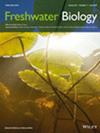Phylogenetic Origin of Morphologically Cryptic Species Shapes Co-Occurrence and Sympatry Patterns
IF 2.8
2区 生物学
Q2 ECOLOGY
引用次数: 0
Abstract
- Cryptic species are an important part of freshwater biodiversity, yet it remains unclear how these species integrate into communities from local to regional geographic scales. To protect biodiversity, particularly overlooked cryptic species, an accurate understanding of the underlying processes and adequate level of protection is needed.
- We analysed patterns of syntopies (local co-occurrences) and sympatries (regional range overlap) to explore how the phylogenetic origin of cryptic species shapes biodiversity patterns. We hypothesised (i) that syntopies were more common among distantly than closely related cryptic species, and (ii) that the existing sympatries were an outcome of phylogenetic relatedness and dispersal.
- The hypotheses were tested on a polyphyletic species complex of subterranean amphipod species (Niphargus rhenorhodanensis complex) by deploying molecular species delimitation, time-calibrated phylogenies, and co-occurrence analyses with probabilistic and generalised linear models (GLM).
- The studied complex comprised 37–48 molecular operational taxonomic units (MOTUs) from nine different clades, with syntopies occurring at random or less frequently than expected. GLM indicated age of divergence did not predict species sympatries, although they emerged more frequently among MOTUs from different clades. Sympatries, however, emerged through dispersal, in MOTUs with large geographic ranges. These mostly overlapped at the foothills of the Alps, the Jura and the Central Massif.
- We conclude that the observed spatial patterns are mainly driven by dispersal and presumably reflect the geographic circumstances of speciation. While species richness on a local scale may be an outcome of competition and dispersal, regional biodiversity patterns presumably arise through a clade-level cascade of historical events, including orogeny and climatic shifts.
形态隐种形态的系统发育起源、共现和共情模式
隐物种是淡水生物多样性的重要组成部分,但这些物种如何从地方到区域地理尺度融入群落尚不清楚。为了保护生物多样性,特别是被忽视的隐蔽物种,需要准确了解潜在的过程和适当的保护水平。我们分析了共型(局部共现)和同型(区域范围重叠)的模式,以探索隐物种的系统发育起源如何影响生物多样性模式。我们假设(i)同型关系在远缘隐种中比在亲缘隐种中更常见;(ii)现存的同型关系是系统发育亲缘关系和扩散的结果。通过分子物种划分、时间校准系统发育以及概率和广义线性模型(GLM)的共现分析,对地下片足类物种(Niphargus rhenorhodanensis复合体)的多种物种复合体进行了假设验证。该复合体由来自9个不同进化支的37-48个分子操作分类单位(motu)组成,其合型是随机发生的或比预期的频率低。GLM表明,分化年龄不能预测物种的同属关系,尽管它们在不同进化枝的motu中出现的频率更高。然而,在地理范围较大的motu中,同乡是通过扩散而出现的。这些山脉大多在阿尔卑斯山麓、汝拉山脉和中央山脉重叠。我们的结论是,观察到的空间格局主要是由扩散驱动的,可能反映了物种形成的地理环境。虽然物种丰富度在局部尺度上可能是竞争和扩散的结果,但区域生物多样性模式可能是通过包括造山运动和气候变化在内的进化层级联历史事件产生的。
本文章由计算机程序翻译,如有差异,请以英文原文为准。
求助全文
约1分钟内获得全文
求助全文
来源期刊

Freshwater Biology
生物-海洋与淡水生物学
CiteScore
5.90
自引率
3.70%
发文量
162
审稿时长
2 months
期刊介绍:
Freshwater Biology publishes papers on all aspects of the ecology of inland waters, including rivers and lakes, ground waters, flood plains and other freshwater wetlands. We include studies of micro-organisms, algae, macrophytes, invertebrates, fish and other vertebrates, as well as those concerning whole systems and related physical and chemical aspects of the environment, provided that they have clear biological relevance.
Studies may focus at any level in the ecological hierarchy from physiological ecology and animal behaviour, through population dynamics and evolutionary genetics, to community interactions, biogeography and ecosystem functioning. They may also be at any scale: from microhabitat to landscape, and continental to global. Preference is given to research, whether meta-analytical, experimental, theoretical or descriptive, highlighting causal (ecological) mechanisms from which clearly stated hypotheses are derived. Manuscripts with an experimental or conceptual flavour are particularly welcome, as are those or which integrate laboratory and field work, and studies from less well researched areas of the world. Priority is given to submissions that are likely to interest a wide range of readers.
We encourage submission of papers well grounded in ecological theory that deal with issues related to the conservation and management of inland waters. Papers interpreting fundamental research in a way that makes clear its applied, strategic or socio-economic relevance are also welcome.
Review articles (FRESHWATER BIOLOGY REVIEWS) and discussion papers (OPINION) are also invited: these enable authors to publish high-quality material outside the constraints of standard research papers.
 求助内容:
求助内容: 应助结果提醒方式:
应助结果提醒方式:


